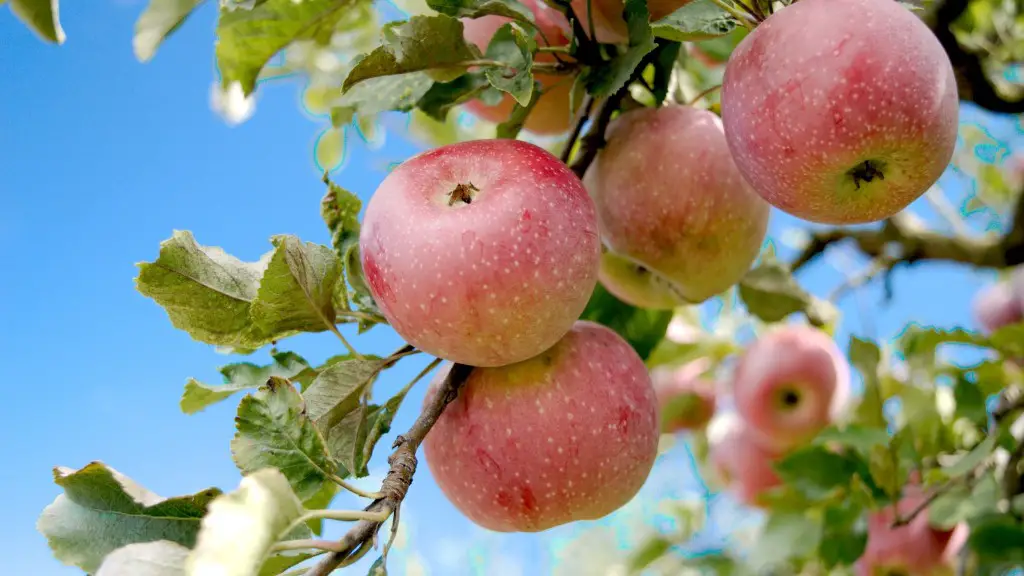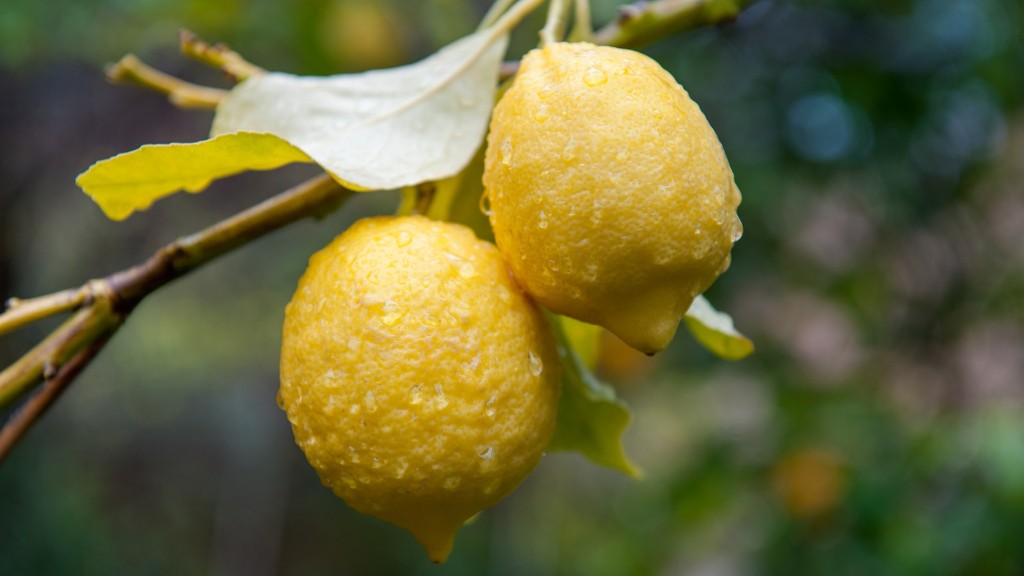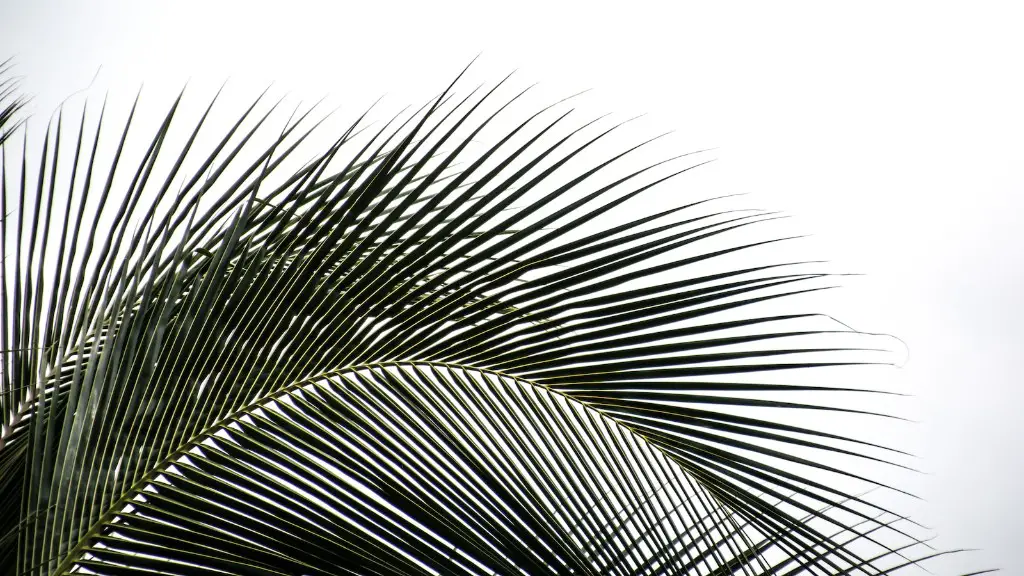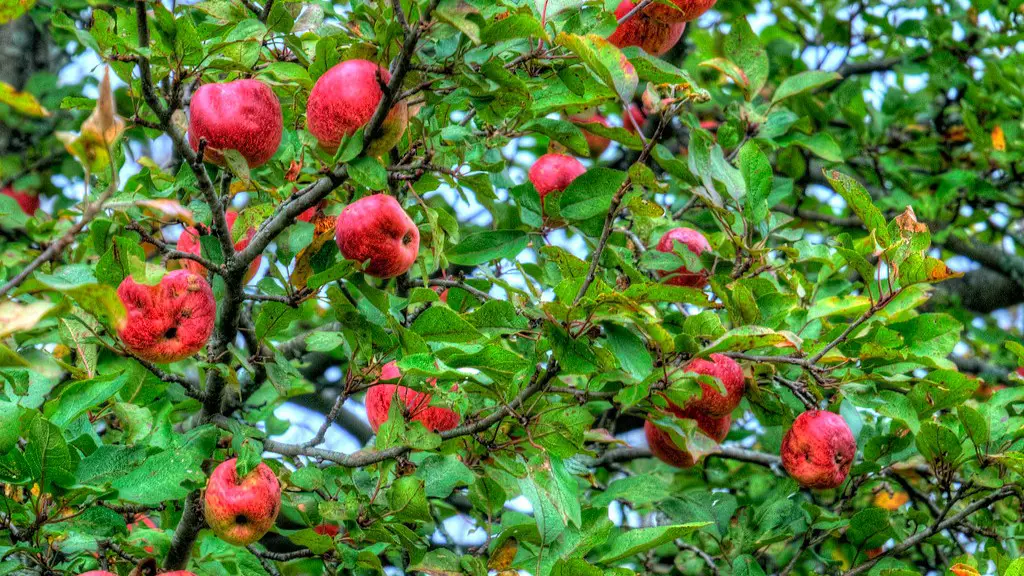The yellowing of apple tree leaves is a common problem for many orchard owners and gardeners. In most cases, the cause of yellow leaves is due to insufficient sunlight, high temperatures and/or inadequate nutrition. In order to identify the cause of yellow leaves, one must understand the natural environment of the apple tree and the available resources.
When leaves turn yellow, it is typically caused by a lack of nutrients and/or sunlight. Inadequate nutrition can occur due to incorrect fertilization, soil pH or nutrient deficiency. Additionally, inadequate sunlight can occur when an apple tree is planted too deeply in the soil or in an area where it is shaded by structures or other plants. In order to provide needed nutrients and/or sunlight, one must analyze the soil pH and fertility as well as check for shade.
High temperatures can also cause leaves to yellow. In the summer, when temperatures are too hot, leaves will typically become dehydrated, turn yellow and in some cases, drop from the tree. In order to prevent this, it’s important to make sure apple trees are properly watered and shaded to help prevent dehydration. Additionally, it’s important to maintain healthy roots and to ensure good drying of leaf surfaces when irrigating.
It’s important to note that any changes in soil composition, water and light levels, or fertilizers must be performed carefully to prevent further damage and stress to the tree. Additionally, any necessary or recommended treatments should be performed by a trained, experienced tree specialist. If you have questions or need assistance identifying the underlying cause of yellow leaves on your apple trees, contact a tree specialist in your area. Check to make sure they have the appropriate certification and experience.
In summary, apple tree leaves may turn yellow for a variety of reasons, such as insufficient sunlight, high temperatures and/or inadequate nutrition. In order to identify the cause of yellow leaves, analyze the soil pH and fertility, check for shade, properly water and shade the tree and, if necessary, contact a tree specialist for advice. Taking these steps can help to prevent further damage and keep your apple trees healthy and productive.
Causes of Apple Tree Leaves Turning Yellow
Apple tree leaves turning yellow can be caused by insufficient sunlight, high temperatures, inadequate nutrition, root health problems or disease. Sunlight is important for apple tree leaves to retain their deep green color and nutrient availability is essential for a thriving and healthy tree. High temperatures can cause leaf dehydration, leading to yellow discoloration. Root health can be directly linked to moisture and soil aeration, which are key to the health of an apple tree’s root system. Additionally, diseases such as apple scab, black stem canker, fire blight, and powdery mildew can cause yellow leaf discoloration.
The prevention of yellowing leaves begins with proper planting. When apple trees are planted in an area with too much shade or too little sunlight, the leaves will begin to turn yellow and in some cases will drop from the tree. Planting in an area with the proper pH balance and soil composition, as well as selecting the right fertilizer for your particular tree, will provide leaves with the nutrients needed to remain healthy.
In addition to sunlight and nutrition, apple trees require focus on root health in order to thrive and prevent yellow leaves. This includes maintaining the correct balance of soil moisture and soil aeration and avoiding planting too deeply in the soil. Additionally, timely fertilizing should be a top priority and follow your local instructions for rate, timing and selection appropriate for your tree and soil.
It is also important to keep an eye out for signs of disease, such as fungal growth, discoloration, spotting or wilting. If symptoms of disease are present, it is important to contact a qualified tree specialist for advice so that quick action can be taken to prevent further damage.
In conclusion, yellow leaves on an apple tree can be cause for concern and signify environmental conditions, inadequate nutrition, disease or root health problems. Proper preventative steps must therefore be taken to ensure that the tree remains healthy and productive.
Controlling Temperature to Prevent Leaf Yellowing
In order to prevent yellowing leaves, one must understand the importance of controlling temperature. When temperatures are too high, leaves can become dehydrated, turn yellow and eventually drop from the tree. To prevent this, it is important to make sure apple trees have adequate water and shaded areas to help prevent excessive dehydration. Additionally, maintaining healthy roots and ensuring good drying of leaf surfaces when irrigating can help to promote a healthy tree.
Temperature control can be achieved in a variety of ways such as planting trees in the recommended full sun and partial shade locations, providing shade cover for the tree, or planting varieties that can withstand higher temperatures. Additionally, it is possible to manually adjust the temperature of the environment around the tree through shading and refrigeration systems, or by providing an adequate water supply.
Additionally, it is important to consider the effects of climate change and weather patterns on temperature levels in an orchard or garden. As climate change continues to cause increasingly hot and dry climates, it is important for orchard owners and gardeners to reflect on their current practices and understand the importance of temperature control in order to protect their apple trees. For example, choosing low-chill varieties that are suited to the local climate or using solutions such as irrigation, water-conserving and cooling systems may be needed in order to protect a tree’s leaves from yellowing.
In conclusion, understanding the importance of temperature control and understanding the effects of climate change can help orchard owners and gardeners protect their apple trees and prevent yellow leaves. By planting the right variety, making the necessary adjustments, and providing an adequate supply of water, one can ensure a healthier environment for their tree and a successful harvest.
Identifying and Treating Underlying Causes of Yellow Leaves
In order to understand and effectively treat the underlying cause of yellow leaves, a thorough examination of the tree’s environment and available resources is essential. This includes analyzing the soil pH and fertility, checking for shade and proper watering and shading of the tree. Additionally, it is important to identify any nutrient deficiencies or incorrect fertilization that may be causing the problem.
For those looking to treat underlying causes of yellow leaves, utilizing soil testing is an effective route to take. This can provide valuable insight into existing soil conditions, soil types, and alkalinity or acidity levels. Additionally, these tests can provide information on nutrient availability, overall soil health, or disease-causing organisms. Utilizing these tests can help identify problems such as soil compaction, poor drainage, and pH imbalances quickly, so that corrective action can be taken to prevent further damage.
Once the underlying cause of yellow leaves has been identified, orchard owners and gardeners should ensure they are taking the appropriate steps to correct the issue. See your local tree specialist for natural, safe, and effective treatments such as tree injections and foliar sprays. Additionally, utilizing beneficial organisms, such as mycorrhizae, to promote soil microbial life, can increase the absorption of essential soil nutrients and help to protect the tree against disease.
In conclusion, diagnosing and treating underlying causes of yellow leaves is an important step for orchard owners and gardeners. By utilizing soil tests, analyzing the environment, and understanding natural treatments, one can significantly reduce the risk of yellowing leaves and prevent further damage to the tree.
Minimizing Stress on Apple Trees
In order to keep yellow leaves to a minimum, it is important to minimize the amount of stress on apple trees. Stress can occur due to a variety of factors including improper pruning techniques, harsh weather conditions, and nutrient removal or deficiency. Additionally, disease, pest infestations, and inadequate water can also cause stress to the tree.
It is important to practice proper pruning techniques to protect the tree from excessive stress. This includes avoiding pruning from the same branch more than once every three years and avoiding pruning of the trunk or main branches of the tree. Additionally, orchard owners and gardeners should ensure that they are providing the correct water requirements for the tree, as too much or too little can cause undue stress. It is also important to regularly check the tree for signs of disease or pests, as this can contribute to stress and cause leaves to yellow.
Another good way to minimize stress is by ensuring trees are adequately fertilized. Fertilizing helps to provide the needed nutrients that can give trees the energy they need to fight off disease or pests and ensure healthy leaf growth. Additionally, it is important to plant trees in an area that is not prone to wind or frost damage, as this can weaken the tree and increase the risk of yellowing leaves.
Finally, it is important to pay attention to the root system of an apple tree. This includes avoiding planting trees too deep in the soil and ensuring that soil is kept aerated and not compacted. Additionally, providing mulch can help to keep the soil cool and moist, as well as minimize stress and any potential damage.
In conclusion, minimizing stress is an important part of preventing yellow leaves. By understanding how to properly prune, water, and fertilize a tree, as well as check for disease and pests, orchard owners and gardeners can ensure a healthy and productive apple tree.





